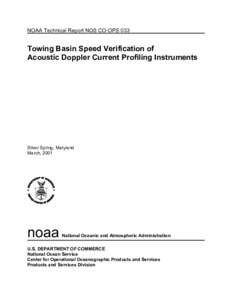| dc.contributor.author | Shih, H.H. | |
| dc.contributor.author | Sprenke, J. | |
| dc.contributor.author | Payton, C. | |
| dc.contributor.author | Mero, T. | |
| dc.date.accessioned | 2018-12-12T19:04:44Z | |
| dc.date.available | 2018-12-12T19:04:44Z | |
| dc.date.issued | 2001 | |
| dc.identifier.citation | Sgih, H.H.; Sprenke, J.; Payton, C. and Mero, T. (2001) Towing Basin Speed Verification of Acoustic Doppler Current Profiling Instruments. Silver Spring, MD, NOAA NOS Center for Operational Oceanographic Products and Services, 53pp. (NOAA Technical Report NOS CO-OPS 033). DOI: http://dx.doi.org/10.25607/OBP-139 | en_US |
| dc.identifier.uri | http://hdl.handle.net/11329/574 | |
| dc.identifier.uri | http://dx.doi.org/10.25607/OBP-139 | |
| dc.description.abstract | With new development in technologies, proliferation of manufacturers, and expanded applications
of acoustic Doppler current profiling instruments, the need for proper sensor test procedures
becomes increasingly important. This report documents a towing basin speed measurement
verification procedure that NOS has adopted for the past decade and a summary of verification
results of forty-one cases consisting of twenty-nine individual sensors. These sensors include
fourteen RD Instruments acoustic Doppler current profiler (ADCP) units (seven 600 and seven 1200
KHz units) and fifteen SonTek acoustic Doppler profiler (ADP) units (three 500 and twelve 1500
KHz units). Some of these sensors were tested repeatedly on different dates prior to deployment.
Tow carriage speeds varied from 5 cm/s to 200 cm/s and were used as references for comparison.
The speed differences between sensor readings and carriage references are expressed in terms of
mean, standard deviation, and percentage of reference speed.
Overall, RDI ADCPs have smaller mean speed differences and standard deviations compared with
SonTek ADPs of similar frequencies. There is a larger sensor-to-sensor variation among SonTek
units, especially among the 500 KHz ADPs. Except for the SonTek 500 KHz units, the standard
deviation and percentage error of the tested sensors were close to manufacturer’s specifications.
Small zero offsets, on the order of 1 cm/s for ADCPs, 2 cm/s for 1500 KHz ADPs, and 5 cm/s for
500 KHz ADPs, were measured. The test results of both sensor types repeat well over time. To aid
in the discussing of test procedure and results, a brief review of related ADCP and ADP design and
operational parameters are also included in this report. | en_US |
| dc.language.iso | en | en_US |
| dc.publisher | NOAA, NOS Center for Operational Oceanographic Products and Services | en_US |
| dc.relation.ispartofseries | NOAA Technical Report NOS CO-OPS;033 | |
| dc.rights | CC0 1.0 Universal | * |
| dc.rights.uri | http://creativecommons.org/publicdomain/zero/1.0/ | * |
| dc.title | Towing Basin Speed Verification of Acoustic Doppler Current Profiling Instruments. | en_US |
| dc.type | Report | en_US |
| dc.description.status | Published | en_US |
| dc.format.pages | 53pp. | en_US |
| dc.description.refereed | Refereed | en_US |
| dc.publisher.place | Silver Spring, MD | en_US |
| dc.subject.parameterDiscipline | Parameter Discipline::Physical oceanography | en_US |
| dc.subject.instrumentType | ADCP | en_US |
| dc.subject.instrumentType | Acoustic Doppler Current Profiler (ADCP) | en_US |
| dc.subject.instrumentType | Instrument Type Vocabulary::current profilers | en_US |
| dc.rights.license | Public Domain | |
| dc.description.currentstatus | Current | en_US |
| dc.description.bptype | Best Practice | en_US |
| dc.description.bptype | Guide | en_US |
| obps.contact.contactemail | coops.webmaster@noaa.gov | |
| obps.resourceurl.publisher | https://tidesandcurrents.noaa.gov/pub.html | en_US |
 Repository of community practices in Ocean Research, Applications and Data/Information Management
Repository of community practices in Ocean Research, Applications and Data/Information Management

